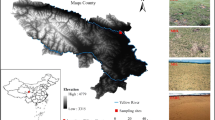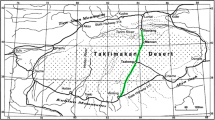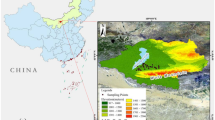Abstract
The stability of soil aggregates and the fractal characteristics of four typical land use types (farmland, grassland, woodland, and bare land) in the Jiangjiagou Ravine (Yunnan, China), a frequent debris flow occurring area, were studied according to the normal mean mass diameter and fractal theory. The present research showed that the stability of the soil aggregates was different for the different land use types. When the soil depth was 0–30 cm, farmland soil formed more aggregates with diameters greater than 0.25 mm, i.e., the farmland soil was more stable than that of the other three land uses. When the soil depth was 30–45 cm, the order of stability of the soil aggregates was woodland > grassland > farmland > bare land. The fractal dimensions had a significant linear positive correlation with the amount of soil particles with diameters of <0.25 mm, and a significant negative linear correlation with the amount of soil particles with diameters of 0.25–0.5 mm, 0.5–1 mm and 1–2 mm. Smaller fractal dimensions of the soil particles correlated with more stable soil aggregates. The fractal dimensions had a positive linear correlation with the soil bulk density and a negative correlation with the concentration of organic matter. These results showed that soil aggregates can be used as a parameter for characterizing the soil structures and properties. According to these results, the soil particle fractal dimensions could not only objectively characterize the stability of the soil structure but also could be used to indicate soil structure and properties. In addition, these results have great significance for the discussion of the comprehensive evaluation of soil.
Similar content being viewed by others
References
Ajiboye B, Akinremi OO, Racz GJ (2004) Laboratory characterization of phosphorus in fresh and oven-dried organic amendments. Journal of Environmental Quality 33: 1062–1069. DOI: 10.2134/jeq2004.1062
Bird NRA, Bartoli F, Dexter AR (1996) Water retention models for fractal soil structures. European Journal of Soil Science 47:1–6. DOI: 10.1111/j.1365-2389.1996.tb01365.x
Chen EF, Zhou LK, Wu GY (1994) Performances of soil microaggregates in storing and supplying moisture and nutrients and role of their compositional proportion in judging fertility level. Acta pedologica Sinica 31(1): 18–25. (In Chinese)
Crist PJ, Thomas WK, John O (2000) Assessing land-use impacts on biodiversity using an expert system tool. Landscape Ecology 15: 47–62. DOI: 10.1023/a:1008117427864
Cui P, Wang DJ, Wei FQ (2005) Model and effect of ecological restoration of dry-hot valley: A case study of the CAS Dongchuan Debris Flow Observation Station. Science of Water and Soil Conservation 3(3): 60–64. (In Chinese)
Friesen JP, Mikula RJ (1987) Fractal space and rock permeability implications. Physical Review B: Condensed Matter and Materials Physics 38:2635–2638
Fu BJ, Chen LD, Ma KM (1999) The effect of land use change on the regional environment in the Yangjuangou catchment in the loess plateau of China. Acta Geographica Sinica 54(3):241–246. (In Chinese)
Gong AD, He YR (2001) Study on Fractal Features of soil structure of degraded soil in dry and hot valley region of Jinsha River. Journal of Soil and Water Conservation 15(3):112–115. (In Chinese)
Kravchenko A, Zhang RD (1998) Estimating the soil water retention from particle-size distribution:a fractal approach. Soil Science 163(3): 171–179.
Le BY (1996) Aggregate stability and assessment of soil crustability and erodibility: I. Theory and Methodology. European Journal of Soil Science 47: 425–437. DOI: 10.1111/j.1365-2389.1996.tb01843.x
Liang SC, Dong M, Wang BS, et al. (2003) Fractal characteristics of particle size distributions of mangroves soils in Yingluo Bay. Chinese Journal of Applied Ecology 14(1): 11–14. (In Chinese)
Li XD, Wei L, Zhang YC, et al. (2009) Effects of land use regimes on soil physical and chemical properties in the Longzhong part of Loess plateau. Acta Prataculturae Sinica 18(4): 103–110. (In Chinese)
Liu YP, Wang GD, Zhang SQ (2003) Fractal characteristics of particle size distribution for four kinds of soil samples in Shanxi. Journal of Northwest Sci-Tech University of Agriculture 31(2): 92–94. (In Chinese)
Long J, Huang CY, Li J (2002) Effects of land use on soil quality in Karst Hilly Area. Journal of Soil and Water Conservation 16(1):76–79. (In Chinese)
Mcdowell RW, Sharpley AN (2004) Variation of phosphorus leached from Pennsylvanian soils amended with manures, composts or inorganic fertilizer. Agriculture, Ecosystems and Environment 102:17–27. DOI: 10.1016/j.agee.2003.07.002
Schwartz RC, Dao TH (2005) Phosphorus extractability of soils amended with stockpiled and composted cattle manure. Journal of Environmental Quality 34:970–978. DOI: 10.2134/jeq2004.0317
Shan L, Xu BC (2009) Discussion on construction stable artificial grassland in half dry area of Loess plateau. Acta Prataculturae Sinica 18(2): 1–2. (In Chinese)
Turcotte DL (1986) Fractal fragmentation. Journal of Geography Research 91(12): 1921–1926. DOI: 10.1029/JB091iB02p01921
Vadas PA (2006) Distribution of phosphorus in manure slurry and its infiltration after application to soils. Journal of Environmental Quality 35: 542–547. DOI: 10.2134/jeq2005.0214
Wang F, Jia ZJ, Dong Z, et al. (2009) Fractal features of soil particle size distribution on water source conservation areas under different measures of ecological restoration. Journal of Soil and Water Conservation 23(5): 113–117. (In Chinese)
Wu JS, Kang ZC, Tian LQ, et al. (1990) Observation and study on debris flow in Jiangjiagou Ravine Yunnan province. Beijing: science press. pp 238–239. (In Chinese)
Yang PL, Luo YP, Shi YC (1993) Use the weight-size distribution to characterize the soil fractal features. Chinese Science Bulletin 38(20): 1896–1899. (In Chinese)
Yang RW, Ye MF, Cheng JR (1998) The compilation of movement observation data in Jiang Jiagou gully. Mountain Research 16(4): 338. (In Chinese)
Zhang YF (1998) The forest engineering technique on desert slope of dry hot valley. Mountain Research 16(3): 248–251. (In Chinese)
Zhang YF (2000) Technique and results of common eulaliopsis’application on exothermic degraded mountain in Jiangjiagou debris flow gully. Journal of Mountain Science 18(6): 563–567. (In Chinese)
Author information
Authors and Affiliations
Corresponding author
Rights and permissions
About this article
Cite this article
Xie, Xj., Wei, Fq. Soil aggregates and fractal features under different land use types in a frequent debris flow area. J. Mt. Sci. 10, 437–444 (2013). https://doi.org/10.1007/s11629-013-2500-3
Received:
Accepted:
Published:
Issue Date:
DOI: https://doi.org/10.1007/s11629-013-2500-3




